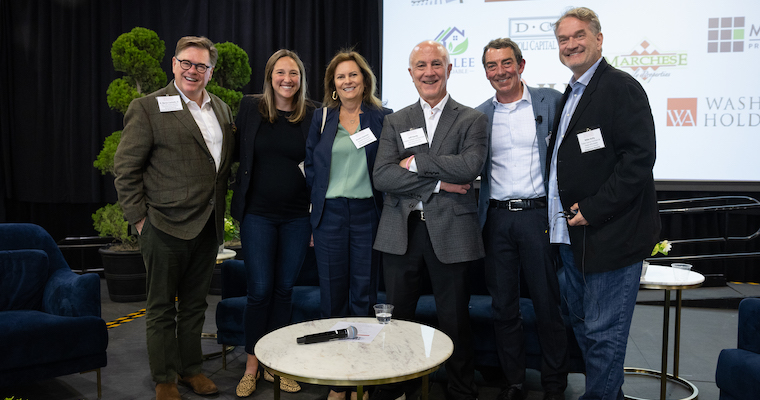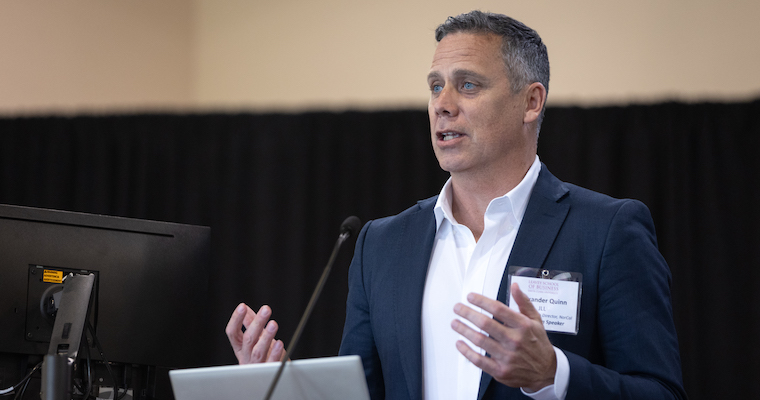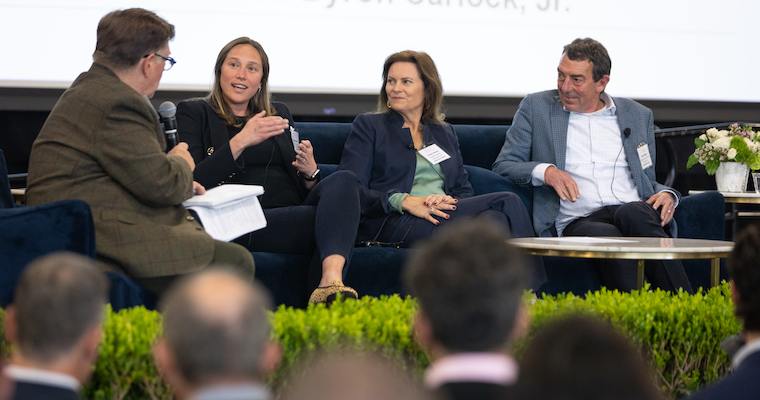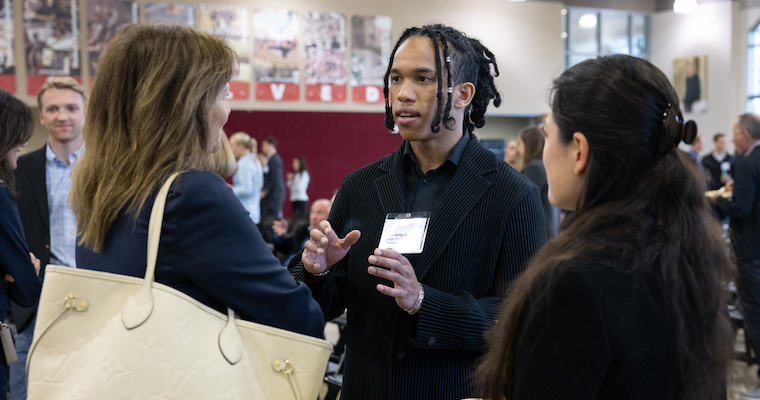
Experts at Annual Leavey Symposium See Glimmers of Light in Gloomy Commercial Real Estate Market
Graduating real estate students are facing a very intimidating commercial market. Interest rates are rising, companies are abandoning their long-held footprints, and debt is soaring.
While it’s impossible to dispute that the market has taken an ugly turn, experts on hand at Leavey’s Seventh Annual Real Estate Symposium, hosted last month by the School’s Real Estate Institute, are not about to panic.
For starters, those that have been in the industry for decades have seen this before—most notably at the end of the eighties in the midst of the savings and loan crisis. “It couldn’t have gotten any worse,” said moderator R. Byron Carlock, Jr., retired partner at PWC. “I think our first home mortgages were at 10-an-a-half, maybe even 12% -- 7% today looks like a bargain. The industry was falling apart. The banking system had collapsed. Loans were being called.”
At the same time, Carlock pointed out that opportunities arose that reshaped the industry. “Loans were being sold for cents on the dollar, and people made billions at the same time,” he said. “We watched the industry transition from development ownership to institutional ownership. We created the formation of REITs. It was amazing how we watched our industry go through a resilient transition, and I’m going to submit that we’re going to see that again.”
A Unique Ecosystem in Uncertain Times
Alexander Quinn, director of research for Northern California at JLL, echoed Carlock’s optimism, making the case that the Bay Area is better positioned than most parts of the country to weather the current storm and emerge strong. He pointed out that the Silicon Valley’s $1.3 trillion economy is roughly the size of Norway’s, and in terms of productivity, the San Francisco Peninsula and Silicon Valley lead the state of California. While this has been a primary contributor to the area’s notoriously high cost of living, it has also largely shielded the region from many of the worst impacts of inflation.
“Housing costs here haven't really increased the same level as they have in Atlanta and Phoenix,” said Quinn. “The scale of the inflation impact is not materially as significant here as it is in other markets.”
Quinn also pointed to the return of international migration into the Bay Area as a sign of ongoing recovery. “The secret of the Bay Area has been that we have been an inflow area for international talent for a long time…39% of residents that live in Silicon Valley are foreign born,” he said. “Nationally we saw international migration decrease by 65% during the pandemic. They were not coming here; the students were not coming here. And that's incredibly important to the Bay Area.”
Quinn noted that over the past two years, those migration numbers have started bouncing back. “What we're seeing is the gateway markets are starting to perform again, even in the Bay area.”
However, while the market itself is showing signs of recovery, Quinn isn’t sure how exactly that will be reflected in the real estate market. “The reality is we don't know what the new normal is. You could sit 20 economists in the room and they would all disagree about what's happening.”
According the Quinn, the uncertainly largely stems from our rapidly changing work habits. “Some people think that we're never going back to the office ever again. Some people think that we're going to do it on a hybrid risk basis. Some people think we're going back to where we were,” he said. “If you go to Seoul right now, the vacancy rate in Seoul, Korea is less than 5%. So it's a totally different type of culture about being in office than here.”
Adding complexity to uncertainty, Quinn pointed out that some types of properties are worse off than others. “We've still seen positive occupancy gains on anything built since 2015, whereas if your buildings are of the 1980s ilk, you're not doing so well.”
A Different Kind of Real Estate Crisis
In addition to a discrepancy in how different properties are faring, there is also a gap in which types of banks are feeling the brunt of the crisis. Joining the symposium remotely, Ron Sturzenegger, former global head of real estate for Bank of America Merrill Lynch and current board member for Conversus, noted that because of the recent work the Fed has done to ensure large banks were well capitalized, smaller banks that service local markets would be the most impacted. “Some of the smaller regional banks are going to find themselves in a terrible time of distress.”
Sturzenegger argued, however, that despite the impact on smaller banks, the industry is in much better shape than during the great recession because measures have been put in place that ensure the larger banks are in a position to absorb that impact. “I don't want anyone to believe the financial system isn't strong compared to how we were in the great financial crisis. Large banks are significantly better capitalized. We learned a lot coming out of [that crisis]. We have stress tests for the big banks, so they have to prove that they can withstand a major stress like we're seeing right now in commercial real estate.”
Sturzenegger predicted that over the coming years, many of the problematic real estate loans (mostly held by smaller banks), will be resold and taken over by new managers. “That creates opportunity… A lot of [small banks] will collapse because they're just overexposed to commercial real estate. But for people in this room, and people who have capital, and people who are willing to get in work and roll up their sleeves, this creates tremendous opportunity as well.”
Matt DiNapoli, president and CEO at DiNapoli Capital Partners agreed. “This is the natural pruning process in real estate. When things are good, we sit around and we go, ‘oh, when prices reset, we're going to go out and we're going to buy everything in sight.’ And now they're reset, and we're all scared to death. We read the headlines, we see what's going on, but these are the times that you have an opportunity to get in when things are going to recover.”
“We've had abysmal growth, so we're stalled. We have trouble building things because of the political environment. Those are all reasons we should be looking at this market and saying, this is good. We have high barriers to entry. At some point, it is going to be a great time to take positions.”
Creativity and Innovation Create Opportunities
Other panelists agreed with DiNapoli’s assessment that the market reset will provide opportunities for experienced, knowledgeable, and creative professionals.
“Anybody could make money in real estate from 2020 to 2022, “said Mike Kelly, president of Tralee Affordable Housing, LLC. “So you had everyone rushing to be in the real estate sector, not knowing what the hell they were doing, who they were doing it with, where they were doing it. They could finance anything, anytime, anyplace by three or four bridge lenders, whatever asset class they were in. And it didn't matter because the rents were going up. The world was a great place; any crappy deal became good because you could refinance it, and everyone looked good.”
“I think one thing that's exciting about this next cycle is you're seeing a lot of creativity that just wasn't required before, and [firms] are looking at things creatively, looking at different capital stack,” added Lauren Balla Alders ‘12, vice president of investments at BentallGreenOak. “So at an office building, maybe the tenant is a part owner, and then they're incentivized to stay in the project. Things aren't as easy as they used to be. And so I think because of that, there's going to be a lot of innovation in this space.”
With a surplus of office space and the high demand for housing in urban centers, converting office buildings to residential is a frequent topic of conversation. However, Carlock pointed out it isn’t as simple as most people think.
“Not every building can be converted,” he said. “It's fascinating that Gensler Architects made the point that a building that was built in the eighties with a large floor plate would collapse if you did the number of perforations necessary to put in that many electrical conduit and plumbing holes to make an office building into apartments—the building would literally collapse. However, if you do it with a building built in the twenties or thirties, it lays out very nicely.”
Whereas profiting on building conversions means having to overcome expensive engineering hurdles, the panelists agreed there is a lot of potential for firms in the area of debt strategy in the short term. “There are several big clients of ours—the government of Singapore is a very big client of ours—and they are not doing anything on the equity side,” said Kristin Gannon, managing director at Eastdil Secured. “They are not buying assets. They are lending. They can buy CMBS tranches, they can go lend mass to someone, or they can just do a permanent loan on an office building at 11% where they were buying office buildings at 5, 6% cap rate. So it seems to me still, and for the next 12, 18 months, that debt is probably where there's going to be greater yields.”
At the Forefront of Societal Change
According to Jeff Hardy, executive director of Leavey’s Real Estate Institute, the goal of this year’s symposium was to bring industry professionals and students together to share a frank conversation about the challenges and opportunities in today’s turbulent market. “We want to be honest with ourselves and our students that this is a very difficult time to be in commercial real estate,” said Hardy. “By bringing these experts to Leavey and Santa Clara University, we can give our students the context they need to understand the real-world implications and opportunities facing today’s professionals.”
Despite all the uncertainty and hurdles, Carlock believes this is an exciting time for experienced leaders in the industry as well as new graduates looking to make their mark.
“Since our country was founded, the real estate industry has relied on a developer and a parcel of land and the phrase location, location, location,” said Carlock. “This next wave is going to be all about bringing four pieces of a diamond together, and that is public investment, private investment, philanthropy and city planning, county planning, national planning.”
“And I'm going to tell you that this industry has the ability to be the social engineer of the change that we are already experiencing as we ride out these transitions that began, frankly, well before Covid, but are continuing. We are redefining the way we use space, where we work, how we work, how we live, what we're willing to pay, what we're not willing to pay, what region of the country, how we want to interact with our transit system. This is an exceedingly, exceedingly exciting time.”







